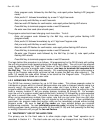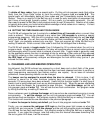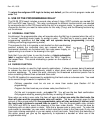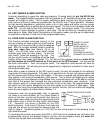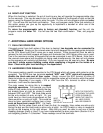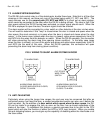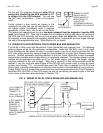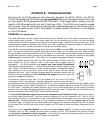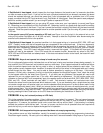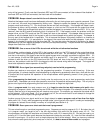Rev. A.2, 10/03 Page-v
PROBLEM-- How to check the Keypad
For reference, when each key is pressed, two terminals will measure zero volts with respect to the WHT (common)
terminal. You can use a voltmeter to see that each key is working correctly. Put the positive probe on WHT and
when key #1 is pressed you will read roughly zero volts on VIO and BRN (the other terminals in the matrix will be
reading about 11 volts. The terminal pair that will show zero volts for the other keys are as follows:
#2 = VIO + GRY #3 = VIO + BLK #4 = PNK + BRN #5 = PNK + GRY #6 = PNK + BLK
#7 = ORG + BRN #8 = ORG + GRY #9 = ORG + BLK #0 = BGE + GRY BELL=BGE +BLK
PROBLEM-- Unusual operation complained of after some operating history
"Unusual" operation can be caused by the microprocessor in the CPU Board being disturbed by electrical noise.
Symptoms can vary quite a bit. The unit may forget its codes, the action of the keypad beeper may become drawn
out or erratic, the timer may function at widely varying ranges, etc. To cure the problem, remove power from the
CPU Board for about 10 seconds, then reconnect it. This forces the microprocessor to reset itself and reload its
program. If the unit has functioned for a long period of time without incident, this may be an adequate fix. The
problem may never reoccur and the end user should be made aware of this simple fix if it should reoccur. All
microprocessors can sometimes "crash" and they are restored by reset. If, however, the problem is more
persistent, steps can be taken to guard against electrical noise problems. You should make sure that the MOV
furnished with the unit is properly installed across the electric lock (review Figures 3-5). The inductive kickback
from electric locks can often be a source of considerable electrical noise. Noise can also come from the keypad
cable, particularly if its length has been extended. There is no specific distance which is a limit for an extended
keypad cable. Shorter is always better as cable noise varies with the proximity of noise producing devices such as
motors, fluorescent or neon lighting etc. The same problem can occur if the cable from an exit switch is extended a
long way from the CPU board. If there are noise sources, it may be necessary to limit the cable run distances while
also trying to avoid the noise sources.
If the problem shows up frequently, it is usually bad power. This particularly occurs when a fail secure lock is
operated from the same supply as the DK-26. When the lock is energized, it may draw too much power for the
power source. This reduces the voltage and these voltage swings can crash the microprocessor. The solution is
either to use a power supply with greater capacity or use two power supplies: one to operate the DK-26 and the
second to operate the fail secure lock through the DK-26's lock control relay.
IF THE PROBLEM PERSISTS
CALL SECURITRON TOLL FREE: 1-800-MAG-LOCK





